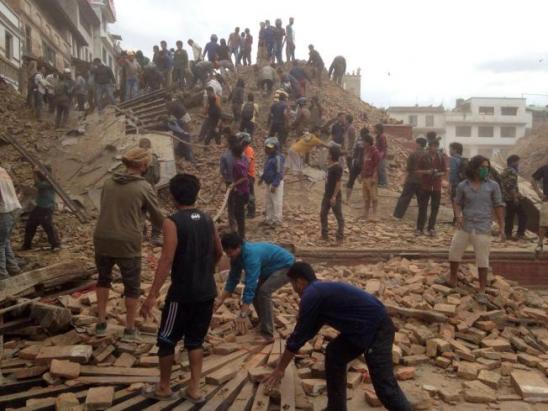Attracted to Calamity: Hollywood and the Uses of Natural Disasters

Where there is a natural disaster of epic proportion, Hollywood is bound to be around the corner seeking to lap it up. Salivating stars are propelled to misery, and big black holes become sites of opportunity for incandescent hope.
In January 2010, we saw the Angelina Jolie and Brad Pitt publicity machine give over $1 million to Doctors Without Borders for the Haiti appeal. At stages it even seemed that donors were seeking to outdo each other. The biggest wallets were meant to front up with heart and good will, outperforming others in a seedy corporate system of donations. There were the tweet challenges. There were the busy telethons. Call up, donate. Fork out, or be damned.
Actress Alyssa Milano, goodwill ambassador to Unicef, even went so far as to throw down the gauntlet to corporate America, a fascinating mirroring of values. “I cried and then I did the only thing I could do… I wrote a check to the US Fund for Unicef for $50,000.” Writing in the Huffington Post (Mar 18, 2010), Milano would speak of her work for Unicef as a series of tourist disaster gigs, a travel log of misery jottings. “I travelled to Angola in 2004, only two years after the peace treaty was signed ending a 27 year civil war. In 2005, I went to India for the 6-month anniversary of the tsunami.” Be on the scene; catch the gloom.
The effect of such disaster anticipation is cinematic – preparatory efforts are made to ready her for the jump into a land of mayhem and natural cruelties. Then come the usual symptoms of middleclass, or at the very least, actor’s guilt. “Sure, I had seen pictures from both places prior to my trips. I watched videos and tried to prepare myself.” Of course, she reminds readers, nothing every quite readies you for the authentic.
The latest round of gory sentimentalising from the Hollywood entertainment complex has issued forth from Susan Sarandon, who has been doing the rounds in devastated, earthquake ravaged Nepal.
The message? Tourism – and more of it. On CNN, she was featured with the expected human ornament heavy with tackiness – the news network’s anointed hero, Pushpa Basnet.[1] Sarandon insisted that, despite whole areas being levelled, monuments could still be seen, museums visited.
As for donations themselves, Sarandon has been issuing a caveat haloed by her expertise.
“It is important that money is sent to places which need it. People are open-hearted but are not diligent enough to see if the stuff they are sending is actually needed.”
Not content with that summation, the thespian suggested that she had the local knowledge, an awareness about what exactly was going on the ground. “I have seen some groups here who are actually accomplishing things so I can help with that.”[2]
Sarandon is also a serial visitor to places of acute devastation. One of her themes is that of the “familiar” house built in the aftermath. These are houses of some resistance, designed to resist the effects of the approaching monsoon. “I have seen this in New Orleans and New York, that you want to help people but with their dignity intact and find their personal objects and the things they have lost.” At a certain point, the paternalistic defender arches up to insist on protecting the dignitas of the subject. Blessed are the poor, because they will save us. Much like concerned adults over vulnerable children. “So they still have a sense of place and home. They are not constantly having things thrown at them and they participate.”
While she can hardly be blamed for some depictions of her, it is still striking that the thespian rarely leaves that allocated role in the popular imaginary. Nothing illustrated this convergence between the violence of natural disaster, and the contrivance of Hollywood sympathy, than the Daily Mail’s description of Sarandon’s fashion on site.
First, the necessary remarks about “two powerful earthquakes which killed thousands of people and posed a serious threat to the nation’s tourism industry, which many need to survive.” Then, a mention about the work with the non-profit outfit Live to Love, with the usual overview about her personal life – splitting up with “boyfriend of five years, 38-year-old filmmaker Jonathan Bricklin.”[3] Proportion is everything in such commentary.
Props are needed, and nothing better presents itself for the camera than a disaster being shaped for popular consumption, with its staged faces, its desperation, its calling. Naturally, the actor shows empathy, a cruel suggestion given that acting, by its very nature, deceives one into envisaging such empathy. This is the catharsis of cruelty. “Empathetic: The Tammy star stopped to comfort a citizen of Ramkot Village, who lost her husband and daughter because of the earthquake.” She was also “caring” and keen to visit those who had lost homes. Plato’s suspicion about thespians and their calibre should never be forgotten.
The most interesting feature to the Daily Mail piece, however, lay in the realm of fashion. Priorities had to be noted. “Susan dressed comfortably for the trip, sporting a fitted black T-shirt and loose-fitting patterned black trousers.” When one travels to earthquake devastated areas, one’s wardrobe should be in good working order.
The fashion genie was particularly busy on this day, noting the coupling “with a coordinated white scarf, and finished off the laid-back look with a pair of black boots.” This is the fashion of the disaster zone, the land of suffering and misery, the saint of the wardrobe. Ultimately, it is all acting.
Dr. Binoy Kampmark was a Commonwealth Scholar at Selwyn College, Cambridge. He lectures at RMIT University, Melbourne. Email: [email protected]


